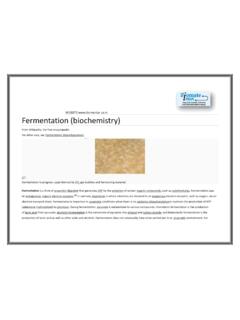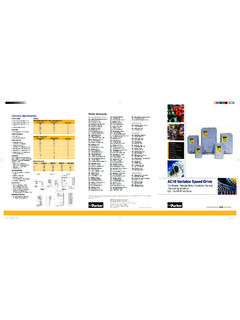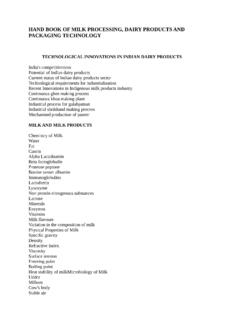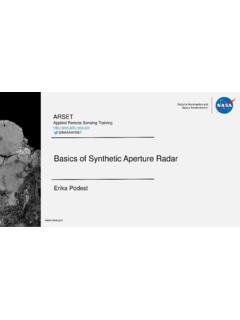Transcription of Hand Book of Synthetic Detergents with Formulations
1 Hand Book of Synthetic Detergents with Formulations Click to enlarge DescriptionAdditional ImagesReviews (0)Related Books Contents Cum Subject Index of the Book I. GROUPS OF Synthetic Detergents : 1. Introduction 2. Classification 3. Anionic Detergents 4. Alkyl Aryl Sulphonates 5. Long-Chain (Fatty) Alcohol Sulphates 6. Sulphonated Olefins 7. Sulphated Monoglycerides 8. Sulphated Ethers 9. Sulphosuccinates 10. Sulphonated Methyl Esters 11. Alkane Sulphonates 12. Phosphate Esters 13. Alkyl Isethionates 14. Acyl Sarcosides 15. Alkyl Taurides 16. Fluoro Surfactants 17. Cationic Detergents 18. Non-ionic Detergents 19. Fatty Alcohol and alkyl Phenol Condensates 20. Fatty Acid Condensates 21. Condensation of Ethylene Oxide with an Amide 22. Block Polymers 23. Sucrose Esters 24. Sorbitan Esters 25.
2 Alkylolamides 26. Fatty Amine Oxides 27. Amphoterics and Zwitterionics 28. Biodegradability II. Synthesis OF Detergents : 1. Introduction 2. Raw Materials for Anionic Synthetic Detergents 3. Fatty Alcohols, Natural and Synthetic 4. Olefins 5. Alpha Olefins 6. Linear Internal Olefins 7. Normal Paraffins 8. Alkyl Benzene 9. Methyl Esters 10. Sulphonation of Detergent Raw Materials 11. The Inorganic Raw Materials for Sulphonation 12. Sulphuric Acid and Oleum (Fuming Sulphuric Acid) 13. Sulphur Trioxide from Oleum Stripping 14. Sulphur 15. Chlorosulphonic Acid 16. Sulphamic Acid 17. Sulphonation with Sulphuric Acid and/or Oleum 18. Sulphonation with Sulphur Trioxide 19. Sulphonation Processes 20. Alpha Olefin Sulphonates (AOS) 21. Methyl Ester Sulphonates 22. Heavy Alkylate Sulphonates 23.
3 Sulphonation with Chlorosulphonic Acid 24. Sulphation by Means of Sulphamic Acid 25. Sulphosuccinates and Sulphosuccinamates 26. Alkane (Paraffin) Sulphonates 27. Phosphate Esters 28. Non-ionic Detergents 29. Ethylene and Propylene Derivatives 30. Fatty Acid Alkanolamides 31. Cationic Detergents 32. Cationic Surtace Active Agents 33. Amphoteric Detergents III. MANUFACTURE OF FINISHED Detergents : 1. Introduction 2. Powder Detergents 3. Simple Absorption 4. Combined Absorption and Neutralisation 5. Dry Mixing of Powders 6. Spray-drying of Powders 7. Colour 8. Particle Size and Spread 9. Bulk Density 10. Residual Moisture 11. Stickiness 12. Product Uniformity 13. Separation of Powder 14. Wet Scrubbing 15. Use of Fines 16. Combination of Spray-dried and Dry-mixed Powders 17. Ballestra 'Combex' System 18.
4 Patterson-Kelley System 19. Anhydro System 20. Drum-drying of Powders 21. Liquid Detergents 22. Toilet Preparations 23. Paste Detergents 24. Calcium Sulphonates 25. Solid Detergents 26. Detergents Toilet Bars 27. Household Scrub Bars 28. Fabric Softeners 29. Abrasive Cleaners IV. FORMULATION AND APPLICATION OF Detergents : 1. Introduction 2. Foam 3. Household Cleaning 4. Heavy-duty Laundering 5. Foam Control 6. Light-duty Household Products 7. General Purpose Detergents 8. Choice of Non-ionic 9. Concentrated Powders 10. Cold Water Washing 11. Hard-Surface Cleaners 12. Machine Dishwashing 13. Abrasive-type Cleaners 14. Miscellaneous Household Cleaners 15. Commerical Laundering 16. Solvent Detergents 17. Carpet and Upholstery Cleaners 18. Textile Dressing 19. Mercerizing 20. Food and Dairy Industries 21.
5 Detergent Sanitisers 22. Metal Cleaners 23. Miscellaneous Cleaners 24. Lavatory Cleaner 25. Hand Cleansers 26. Waterless Hand Cleaners V. PERFUMING OF SOAPS AND Detergents : 1. Introduction 2. Types of Perfumes 3. Matching a Perfume 4. Formulation of Perfumes in Soap Compounds 5. Antiseptic and Medicated Soaps 6. Perfuming Boxes VI. TESTING OF SOAPS AND Detergents : 1. Introduction 2. Test Methods 3. Statistical Presentation of Data 4. Radioactive Tracer Technique 5. Water Hardness 6. Screening Tests 7. Acid Stability 8. Acid Stability test Method 9. Alkali Stability and Solubility in-Caustic Soda Solutions 10. Test method-Alkali Stability 11. Test Method-Solubility 12. Stability toward Metallic Lons 13. Test Method 14. Surface and Interfacial Tension Values and Spreading Coefficient 15.
6 Surface Tension 16. Interfacial Tension 17. Surface Active Agents 18. Test Method 19. Lime Soap Dispersion 20. Test, Method 21. Practical Wetting Tests 22. Test Method : Draves-Clarkson Test 23. Canvas Disk Test Method 24. Rewetting Test 25. Test Method 26. Lather Values 27. Test Method : Ross-Miles Pour Foam Test 28. Solubility-Organic Solvents 29. Test Method 30. Cotton Washing 31. Water Hardness 32. Machines 33. Standard Cotton Soil Fabric Preparation 34. Fabric Choice 35. Desizing 36. Soil 37. Soiling Machine 38. Soil Storage 39. Evaluation of Washed Swatches 40. Standardization of Solid Fabric Testing 41. Cotton Wash Test Methods 42. Deter-Meter Test Method 43. Conventional Washer Method 44. Practical Wash Tests 45. Home Laundering 46. Sea Water Detergency Tests 47. Detergency Methods 48.
7 Redeposition 49. General Methods 50. Redeposition Test Procedure 51. Wool Washing 52. Raw Wool Scouring 53. Continuous Scouring of Raw Grease Wool 54. In-Process Scouring 55. Soiled Suspension 56. Soiled Fabric Preparation 57. AATCC Detergency Comparator 58. Test Method 59. Finished Fabric Scouring 60. Wash Test Method 61. Washing Procedures for other Fibres 62. Dry Cleaning 63. Shampoos 64. Detergency Method 65. Lather-Shampoo 66. Hard Surface Cleaning 67. Metal Cleaning 68. Performance Tests 69. Surfaces 70. Soils 71. Machines for Removal 72. Sample 73. Estimation of Soil Removal 74. Dishwashing 75. Soil 76. Measurement of Soil Retention (or removal) 77. Machines for Washing 78. Miscellaneous Tests 79. Brightening Agents 80. Evaluation 81. Ph Determination 82. Proposed Method of Test for pH of Aqueous Solutions of Soaps and Detergents 83.
8 Corrosion VII. Manufacturing OF HERBAL Synthetic Detergents : 1. Performance Criteria 2. Washing Habits 3. Quality of Water 4. Soiling 5. White vs. Coloured Clothes 6. Manufacturing Facilities 7. Safety and Pleasant 'in-use' Qualities 8. Colour, Odour and Flow Characteristics 9. Shelf Life 10. Pricing 11. Formulation Requirements 12. Alkalinity 13. Good Building and Active Matter 14. Approach to Product Formulation 15. Production Procedure 16. Formulations of Synthetic Detergent Powders 17. Detergent Powder Prepared Without Using Spray Dryer (High Bulk Density) 18. Procedure 19. Foam Regulation 20. Typical Suds Regulated Surfactant Compounds 21. Woollen Piece Goods Scouring-Preparation 22. Scouring Powders Including Kitchen Cleaners 23. Abrasives 24. Surfactants 25. Other Chemicals 26.
9 Soap Powder 27. Manufacturing Process 28. Standards VIII. Detergents BARS : 1. Introduction 2. Requirements of a Detergent Bar 3. NSD Bar Vs. Soap 4. Components of Detergent Bars 5. Active Detergent 6. Sodium Tripolyphosphate 7. Talc 8. Starch 9. China Clay 10. Calcite 11. Soda Ash 12. Sodium Sulphate 13. Sodium Silicate 14. Coconut Mono Ethanolamide 15. Soapstock 16. Dicalcium Phosphate 17. Rosin 18. Titanium Dioxide 19. Colour 20. Fluorescer 21. Perfume 22. Water 23. Processing of NDC Bars 24. Handling of Raw Materials 25. Processing 26. Process Control 27. Some Typical Formulations of Detergent Bar 28. Plant & Machinery for Small Scale Detergent 29. cake Manufacture 30. Kneader 31. Milling Machine 32. Plodder 33. Bar Cutter or Billet Cutter 34. Embossing or Stamping Machine 35.
10 Pulverizer IX. HERBAL LIQUID AND PASTE Detergents : 1. Requisites of Surfactants for Formulating Liquid Detergents 2. Surfactants Most Commonly Used 3. Builders 4. Viscosity Controllers 5. Other Ingredients 6. Household Liquid Detergents for Laundering 7. Heavy Duty 8. Manufacture of Paste Detergents 9. Formulations of Liquid and Paste Detergents 10. Heavy Duty Liquid Detergents 11. Light Duty Detergents 12. Liquid Shampoo 13. Procedure 14. Light Duty : (for silk, wool etc.) 15. Typical Formulations 16. Procedure 17. Shampoos 18. Rug Cleaning Liquid Detergent Formulations 19. A Recommended Formulation 20. Heavy-duty Liquid Detergents X. ACID SLURRY BY MANUAL PROCESS : 1. Raw material Requirements 2. Process of Manufacture 3. Plant Economics 4. Plant & Machinery 5. Fixed Capital 6.













